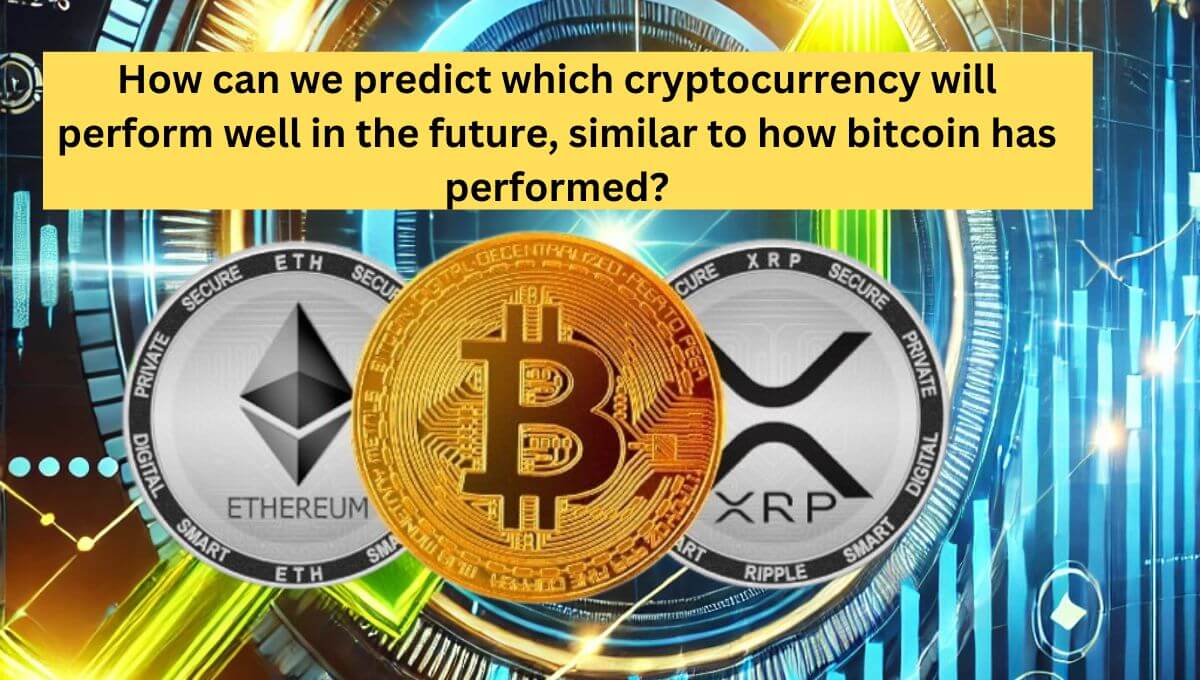How can we predict which cryptocurrency will perform well in the future, similar to how bitcoin has performed : Bitcoin has not only set trends in cryptocurrency trading by pioneering decentralized peer networks; it has become the de facto standard, garnering legions of followers and spinoffs over time.

As there is more than one cryptocurrency available, researching others and seeing which are performing well besides Bitcoin is crucial. Here are some alternative cryptocurrencies which have managed to remain consistent through steep price climbs and drops.
What Are Cryptocurrencies (or Digital Currencies)?
Before exploring some of these Bitcoin (BTC) alternatives in depth, let’s briefly cover what constitutes cryptocurrency and altcoin:
Cryptocurrencies, or virtual or digital money, can be broadly defined as virtual or digital currencies which come in the form of tokens or coins.
Altcoins are cryptocurrencies designed to look similar to Bitcoin and have often attempted to present themselves as enhanced versions of it.
Cryptocurrencies rely heavily on cryptographic techniques (techniques and technologies) for creating and processing digital currencies, known as “crypto.” Additionally, there is an emphasis on remaining decentralized: teams typically develop these currencies together to incorporate mechanisms for issuing and controlling them.
Cryptocurrencies were originally designed to be independent from government regulation; however, with their increased popularity has come regulatory developments that threaten this principle of the industry.
See More : Bitcoin, Ethereum, & XRP Price Prediction for February 2025
Types of Altcoins
Cryptocurrencies
Cryptocurrencies are intended for payments, functioning like digital money that transmits value between decentralized users. Many altcoins (other than Bitcoin or Ethereum) fall under this classification.
Tokens
There are also blockchain-based tokens designed to serve other functions than money. One such example could be tokens issued as part of an initial coin offering (ICO), representing stakes in blockchain or decentralized finance projects such as DeFi. If these tokens correspond with company or project values they could also be considered security tokens (though technically these don’t fall under securities like stocks).
Other tokens have specific use cases or functions; examples include Storj tokens which enable people to share files across a decentralized network or Namecoin which provides decentralized Domain Name System (DNS) service for internet addresses.12
Namecoin FAQ.
These tokens are known as utility tokens.
While many crypto users understand and appreciate these differences, traders and lay investors may be unaware of them due to how tokens trade on exchanges in similar fashion.
Ethereum (ETH)
Ethereum (ETH), our first alternative to Bitcoin that we’ve listed, is a decentralized software platform which enables smart contracts and decentralized apps (dApps) to be created and operated without fraud, oversight or interference from outside sources. Ethereum was designed with one primary aim in mind – providing any person anywhere access to financial products regardless of race, nationality or religion – making its accessibility particularly relevant in certain countries without government infrastructure or identification cards as individuals can gain access to bank accounts, loans insurance services and various financial products through it.
Ethereum utilizes ether, an exclusive cryptographic token designed for use on its platform. Ethereum (ETH) will be utilized for payments to validators who stake their money to work on the blockchain, off-chain payments and investments from speculators.
Ether (ETH) has held onto second place in market capitalization behind only Bitcoin for quite some time, though its market capitalization of nearly $294 billion lags significantly behind that of the most popular cryptocurrency by some distance. Ether’s price at time of writing (Jan 31, 2025, ) stood at approximately $2,436, making up half of Bitcoin’s market cap value.
Tether (USDT)
Tether (USDT) was among the earliest and most enduring of the stablecoins: cryptocurrency alternatives that attempt to link their market value with another external reference point to reduce price volatility. Given that many digital assets like Bitcoin experience periods of extreme price swings, Tether and other stablecoins attempt to ease price fluctuations to attract users who might otherwise remain cautious.
Tether’s price is tied directly to that of the United States Dollar because its developers claim that for every circulating USDT they hold one U.S. dollar or an equivalent sum. This allows users to quickly convert other cryptocurrencies back to USDT using this system without actually exchanging currency into it first.
Launched in 2014, this cryptocurrency allows individuals to utilize blockchain networks and related technologies in order to transact traditional currencies while mitigating some of the risks and complexities that accompany digital currencies.
Tether was the third-largest cryptocurrency by market capitalization as of Jan 31, 2025, with an estimated market cap of $119.70 billion and per token value of $0.999.5
Binance Coin (BNB)
Binance Coin (BNB) is a utility cryptocurrency designed to serve as payment for trading fees on the Binance Exchange. As of 2017, it holds fourth place by market capitalization on CoinMarketCap. “Binance Coin: BNB.”
Users who opt to pay with tokens at an exchange can take advantage of a discounted trading environment.
Binance Coin’s blockchain also serves as the basis of Binance Exchange’s decentralized exchange service, established by Changpeng Zhao and one of the most frequently utilized exchanges worldwide.
Binance Coin was initially launched as an ERC-20 token running on Ethereum blockchain. After launch of mainnet and adoption of PoS consensus model, market capitalization reached $82.70 billion by Jaunary 31, 2025 with each BNB valued at around $567.00 each.
Solana (SOL)
Solana was launched in 2017 as a blockchain platform designed to facilitate decentralized applications (dApps). Dubbed an ‘Ethereum killer,” Solana performs significantly more transactions per second than Ethereum while charging lower transaction fees.
Solana and Ethereum both utilize smart contracts, which are essential in running cutting-edge applications like decentralized finance (DeFi) and non-fungible tokens (NFTs).
Solana (SOL), the cryptocurrency running on the Solana blockchain, has seen incredible price gains since its debut. Since January 2024, Solana had amassed a market capitalization of more than $68.4 billion and was worth about $149.95 on Jan 31, 2025, becoming one of the fifth-largest cryptocurrencies by market cap.
USD Coin (USDC)
USD Coin is another stablecoin which pegs its price to the U.S. dollar by using fiat-collateralized reserves – that is, holding an amount equal to how many USD Coin are in circulation – similar to its namesake coin USDC from 2018. Introduced by Centre Consortium which at one point included Circle and Coinbase but no longer participates – USDC falls under regulation laws due to Circle’s presence within America, making USDC an regulated stablecoin.
XRP
Ripple created the XRP Ledger as a payment system in 2012 and uses an innovative consensus mechanism called the XRP Ledger Consensus Protocol that does not use proof-of-work or proof-of-stake validation; rather, client applications send their transactions directly to its servers, where servers compare each one before making their decision about inclusion into the ledger.
Servers then send transaction candidates to validators, who work to confirm that servers got it right and record ledger versions accordingly.
Dogecoin (DOGE)
Dogecoin (DOGE), often considered the original “memecoin,” caused quite an uproar in 2021 as its price began to spiral skyward. The coin, featuring an image of Shiba Inu as its avatar, has since been accepted by some major companies as payment.
Dogecoin was invented by software engineers Billy Markus and Jackson Palmer as an ironic way of commenting on the volatility in the cryptocurrency market. According to them, it was meant as an eye-roller.
Tron (TRX)
In 2017, The TRON Foundation was created with a mission of providing digital content makers full ownership rights through tokenization and decentralized apps (dApps). Developers wanted a way to build apps using TRX. By 2018, TRON acquired BitTorrent file-sharing program and integrated it into its blockchain, eventually transitioning towards serving as a decentralized financial application platform.
TRON’s native token, TRX, can be used both on-chain transactions and exchanges as payment. Anyone holding TRX may apply to become a Super Representative who has the authority and obligation to validate transactions and create new blocks on the blockchain. TRON uses a variation on Ethereum’s proof-of-stake called designated Proof-of-stake (DPoS), in which voting takes place by network participants for selecting Super Reps.
oncoin (TON)
Toncoin (TON) was initially developed by Telegram team and used on The Open Network; however, after SEC filed charges against it for unregistered security offering in 2020, the project was taken over by Pavel Durov’s brother Dr. Nikoli Durov of Telegram and development continued through The TON Foundation.
Cardano (ADA)
Cardano (ADA) is an “Ouroboros Proof-of-Stake” cryptocurrency developed using an academic research-driven approach by engineers, mathematicians and cryptography specialists. Charles Hoskinson co-founded Cardano as one of five original founding members of Ethereum before departing to help create it alongside Cardano’s other co-founders. After disagreeing with Ethereum’s direction he created Cardano and later helped found Cardano as part of an alternative cryptocurrency project.
Cardano’s team developed its blockchain through extensive experimentation and peer-reviewed research.15 Researchers behind this project have published over 120 papers related to blockchain technology across various topics – this research forms the cornerstone of Cardano.
Due to this rigorous process, Cardano stands out among its PoS peers and other prominent cryptocurrencies. Cardano has even been labeled an “Ethereum killer”, as its blockchain has the capacity to offer more services than Ethereum does. Yet Cardano remains in its early stages with regards to DeFi applications – this process still has much progress ahead.
Cardano strives to become the global financial operating system through creating DeFi products similar to Ethereum’s. Cardano plans on providing solutions for chain interoperability, voter fraud protection and legal contract tracing among others. On Jaunary 31, 2025 it had an 11th largest market capitalisation at $12.32 billion while one ADA could be purchased for around $0.35.
FAQs
Which coin is most similar to Bitcoin?
Ethereum (ETH) The first Bitcoin alternative on our list, Ethereum (ETH), is a decentralized software platform that enables smart contracts and decentralized applications (dApps) to be built and run without downtime, fraud, control, or interference from a third party.
What is the next investment like Bitcoin?
| Coin | Market Capitalization | Current Price |
| Bitcoin (BTC) | $2.06 trillion | $104,353.78 |
| Ethereum (ETH) | $391.56 billion | $3,246.31 |
| Binance Coin (BNB) | $96.71 billion | $678.83 |
| Solana (SOL) | $115.54 billion | $237.54 |
| Ripple (XRP) | $178.36 billion | $3.09 |
| Dogecoin (DOGE) | $47.44 billion | $0.32 |
| Cardano (ADA) | $33.44 billion | $0.9504 |
| Avalanche (AVAX) | $14.24 billion | $34.60 |
| Shiba Inu (SHIB) | $10.96 billion | $0.0000186 |
| Polkadot | $9.51 billion | $6.16 |
What will happen with Bitcoin in future?
Bitcoin’s future in 2025 depends on a range of factors, ranging from institutional adoption and technological innovation to regulatory clarity. Though short-term volatility remains likely, its long-term outlook remains bright thanks to adoption trends and monetary properties driving its development.
Which coin can replace Bitcoin?
Ether differs significantly from Bitcoin by being more than just a tool for peer-to-peer payments; instead, its blockchain provides smart contracts, decentralized finance tools and Web3 applications as well as trading of non-fungible tokens or NFTs.



